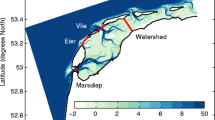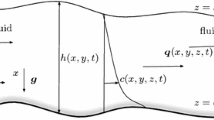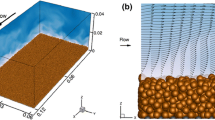Abstract
Suspended sediment transport processes in a short tidal embayment with a simple geometry are investigated using analytic and numerical models. On the basis of numerical results, the horizontal gradient of depth-averaged suspended sediment concentration can be parameterized with a combination of the first harmonic and mean. Using the parameterization, the solution of the analytic model is obtained. Evaluation of the major terms from the solution of the analytic model shows that a quarter-diurnal frequency is significant near the mouth while a semidiurnal component dominates the interior area. The settling lag consists of local and nonlocal components. The local phase lag is a function of the ratio between tidal period and settling time. The nonlocal phase lag is determined by the phase difference between tidal velocity and the horizontal gradient of sediment concentration and by the strength of erosion and horizontal advection.










Similar content being viewed by others
References
Allen, G.P., J.C. Salomon, P. Bassoullet, Y. Du Penhoat, and C. De Grandpre. 1980. Effects of tides on mixing and suspended sediment transport in macrotidal estuaries. Sedimentary Geology 26: 69–90.
Bass, S.J., J.N. Aldridge, I.N. McCave, and C.E. Vincent. 2002. Phase relationships between fine sediment suspensions and tidal currents in coastal seas. Journal of Geophysical Research 107C10: 3146. doi:10.1029/2001JC001269.
Burchard, H., and H. Baumert. 1998. The formation of estuarine turbidity maxima due to density effects in the salt wedge: A hydrodynamic process study. Journal of Physical Oceanography 28: 309–321.
Dronkers, J. 1986. Tidal asymmetry and estuarine morphology. Netherlands Journal of Sea Research 20: 117–131.
Dyer, K.R. 1997. Estuaries: A physical introduction. 2Chichester: John Wiley & Sons.
Friedrichs, C.T., B.D. Armbrust, and H.E. De Swart. 1998. Hydrodynamics and equilibrium sediment dynamics of shallow, funnel-shaped tidal estuaries. In Physics of estuaries and coastal seas, eds. J. Dronkers, and M. Scheffers, 315–327. Amsterdam: Balkema.
Ganju, N.K., D.H. Schoelhamer, J.C. Warner, M.F. Barad, and S.G. Schladow. 2004. Tidal oscillation of sediment between a river and a bay: a conceptual model. Estuarine, Coastal and Shelf Science 60: 81–90.
Geyer, W.R. 1993. The importance of suppression of turbulence by stratification on the estuarine turbidity maximum. Estuaries 16: 113–125.
Groen, P. 1967. On the residual transport of suspended matter by an alternating tidal current. Netherlands Journal of Sea Research 3: 564–574.
Ianniello, J.P. 1977. Tidally induced residual currents in estuaries of constant breath and depth. Journal of Marine Research 35: 755–786.
Jay, D.A., and J.D. Musiak. 1994. Particle trapping in estuarine tidal flows. Journal of Geophysical Research 99: 445–461.
Postma, H. 1967. Sediment transport and sedimentation in the estuarine environment. In Estuaries, Publ. 83, ed. G. H. Lauff, 158–179. Washington, D. C.: Am. Assoc. for the Adv. of Sci.
Prandle, D. 2004. Sediment trapping, turbidity maxima, and bathymetric stability in macrotidal estuaries. Journal of Geophysical Research 109: C08001. doi:10.1029/2004JC002271.
Pritchard, D. 2005. Suspended sediment transport along an idealized tidal embayment: settling lag, residual transport and the interpretation of tidal signals. Ocean Dynamics 55: 124–136.
Ridderinkhof, H. 1997. The effect of tidal asymmetries on the net transport of sediments in the Ems Dollard Estuary. Journal of Coastal Research 25: 41–48. (Special Issue).
Sanford, L.P., and M.-L. Chang. 1997. The bottom boundary condition for suspended sediment deposition. Journal of Coastal Research 25: 3–17.
Schubel, J.R. 1968. The turbidity maximum of the Chesapeake Bay. Science 161: 1013–1015.
Schuttelaars, H.M., and H.E. De Swart. 1996. An idealized long-term morphodynamic model of a tidal embayment. European Journal of Mechanics B/Fluids 15: 55–80.
Shchepetkin, A.F., and J.C. McWilliams. 2005. The Regional Ocean Modeling System (ROMS): A split-explicit, free-surface, topography-following coordinates ocean model. Ocean Modelling 9: 347–404.
Speer, P.E., and G.G. Aubrey. 1985. A study of non-linear tidal propagation in shallow inlet/estuarine systems Part II: theory. Estuarine, Coastal and Shelf Science 21: 207–224.
Warner, J.C., C.R. Sherwood, H.G. Arango, and R.P. Signell. 2005. Performance of four turbulence closure models implemented using a generic length scale method. Ocean Modelling 8: 81–113.
Weeks, A.R., J.H. Simpson, and D. Bowers. 1993. The relationship between concentrations of suspended particulate material and tidal processes in the Irish Sea. Continental Shelf Research 13: 1325–1334.
Author information
Authors and Affiliations
Corresponding author
Rights and permissions
About this article
Cite this article
Cheng, P., Wilson, R.E. Modeling Sediment Suspensions in an Idealized Tidal Embayment: Importance of Tidal Asymmetry and Settling Lag. Estuaries and Coasts 31, 828–842 (2008). https://doi.org/10.1007/s12237-008-9081-4
Received:
Revised:
Accepted:
Published:
Issue Date:
DOI: https://doi.org/10.1007/s12237-008-9081-4




